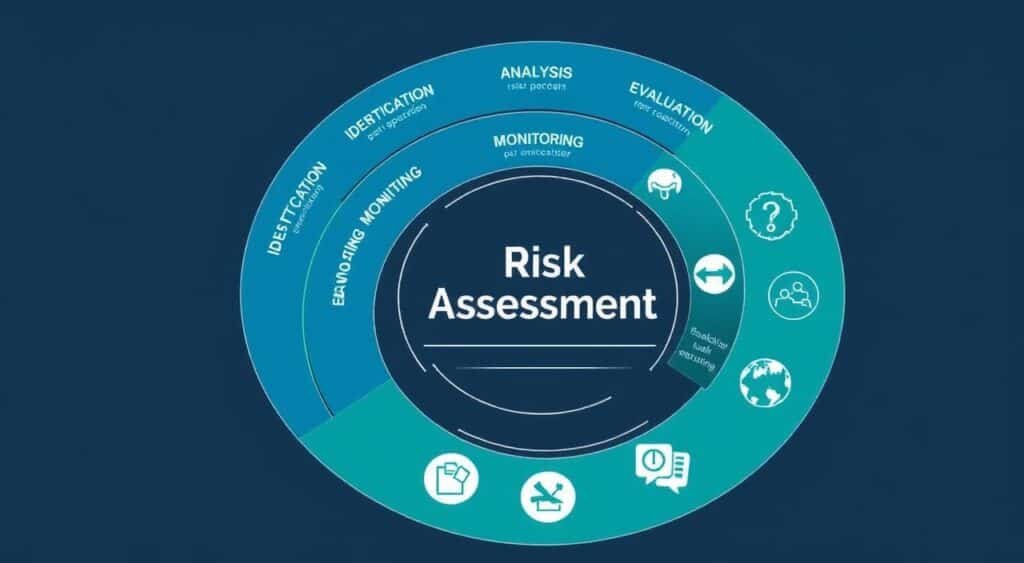Risk mitigation is key in insurance policies. It gives businesses financial protection and lessens risk impacts. Insurance acts as a financial safety net, helping companies manage and transfer risks.
For new and small businesses, the right insurance policies are vital. They protect against property damage, liability claims, data breaches, and supply chain issues. Insurance also limits costs and speeds up recovery from unexpected events.
Key Takeaways
- Risk mitigation is essential for business protection and sustainability
- Insurance policies serve as a financial safety net, transferring risks
- Properly structured insurance helps limit out-of-pocket expenses
- Insurance facilitates quicker recovery after unexpected incidents
- Risk management is crucial for new and small businesses
Understanding Risk Management Fundamentals in Insurance
Risk management is key in the insurance world. It helps identify, assess, and tackle different risks. This is vital for a business’s success and survival. Insurance companies and their clients face risks like operational risk, financial risk, legal and compliance risk, and strategic risk.
Types of Business Risks and Their Impact
Operational risks include tech failures, supply chain issues, and human mistakes. These can cause service stops, money losses, and harm to reputation. Financial risks involve market changes, credit problems, and cash flow issues. They can threaten a company’s financial health.
Legal and compliance risks include fines, data breaches, and legal troubles. These can hurt a company’s finances and reputation. Strategic risks come from big decisions, like new markets or changes in the industry. They can affect a business’s future.
The Connection Between Insurance and Risk Management
Insurance is crucial for managing risks. It offers financial protection and encourages good risk handling. By sharing risks with insurers, businesses can avoid big losses. They can then focus on their main work.
Insurance companies also help clients manage risks. They work together to find and solve risk problems. This approach helps manage risks in a complete way.
Financial Implications of Risk Management
Good risk management has big financial benefits. Businesses that manage risks well often pay less for insurance. Insurers see their efforts to reduce risks.
On the other hand, ignoring risk management can lead to more claims. This can increase costs and premiums over time.
| Risk Type | Description | Potential Impact |
|---|---|---|
| Operational Risk | Challenges related to technology, supply chain, and human error | Service interruptions, financial losses, reputational damage |
| Financial Risk | Market fluctuations, credit defaults, liquidity issues | Financial instability, insolvency |
| Legal and Compliance Risk | Regulatory penalties, data privacy breaches, legal liabilities | Financial and reputational consequences |
| Strategic Risk | Risks associated with decision-making, such as entering new markets | Long-term viability of the business |
“Actively managing risks and controlling losses can lead to lower insurance premiums.”
Essential Components of Risk Mitigation

Effective risk mitigation in insurance policies needs a detailed approach. It covers risk identification, risk assessment, risk prioritization, risk response, and risk monitoring.
The first step is risk identification. Insurance providers work with stakeholders to find potential threats. This helps them understand all risks they face.
Then, risk assessment looks at how likely and big each risk could be. This helps them focus on the most important risks and use their resources wisely.
- Regulatory frameworks and auditing standards like PCI-DSS, SOC 2, and HIPAA require systematic risk management.
- Risk analysis helps decide which risks to tackle first by looking at their likelihood and impact.
Risk prioritization is key. It makes sure the most serious risks get the most attention and action. This means ranking risks by how bad they could be and how likely they are to happen.
The risk response stage is about picking the best way to deal with risks. This could be avoiding the risk, transferring it (like with insurance), reducing it, or accepting it. Choosing and using these strategies is vital to lessen the harm from possible threats.
| Risk Mitigation Strategy | Description |
|---|---|
| Risk Avoidance | Eliminating the risk by avoiding the activity or situation that could lead to the risk |
| Risk Transfer | Transferring the risk to a third party, such as through insurance coverage |
| Risk Mitigation | Implementing measures to reduce the likelihood or impact of the risk |
| Risk Acceptance | Acknowledging the risk and accepting its potential consequences |
Finally, risk monitoring and review are crucial. They help adjust to new risks and check if the strategies are working. Regular checks and clear talks with stakeholders keep a strong risk management culture.
By focusing on these key areas, insurance providers can create strong plans to protect their businesses and customers from threats.
Insurance as a Strategic Tool for Business Protection

In today’s fast-changing business world, insurance is key for protecting companies of all sizes. It offers many coverage options to help businesses deal with risks and stay strong over time. From business interruption insurance to liability management solutions and property protection measures, insurance gives businesses a solid way to stay financially safe and keep running.
Business Interruption Coverage
Business interruption insurance is vital for companies, especially new ones with thin margins and little emergency cash. It helps with money needed during unexpected stops, covering lost income and ongoing costs. This insurance ensures businesses keep going, keep customers happy, and stay strong through tough times.
Liability Management Solutions
General liability insurance is a must for businesses, protecting them from claims of injury, damage, and more. It covers legal costs and settlements, encouraging businesses to manage risks well. This leads to lower insurance costs and fewer legal worries.
Property Protection Measures
Property insurance protects a company’s buildings, equipment, and stock from damage or loss. This includes fires, natural disasters, or theft. It helps businesses stay running and recover fast, keeping them strong for the long haul.
By using insurance in their risk plans, businesses become more flexible and ready for surprises. Insurance is more than just protection; it’s a way to manage risks well. This makes businesses more stable and able to grow.
| Insurance Coverage | Key Benefits |
|---|---|
| Business Interruption Insurance | Covers lost profits and ongoing expenses during unexpected disruptions, ensuring business continuity |
| General Liability Insurance | Protects against claims of bodily injury, property damage, and other liabilities, managing legal costs and settlements |
| Property Insurance | Reimburses losses from fire, natural disasters, or theft, helping businesses maintain operational capabilities and recover quickly |
“Insurance has the potential to help businesses create more resilient and sustainable operations, providing greater flexibility, agility, financial security, proactive risk management, and new revenue streams.”
Implementing Effective Risk Mitigation Strategies

Creating a solid risk mitigation plan is key for businesses to keep their operations safe and finances secure. They must research laws, pick the right building sites, and use methods like uninterruptible power supplies. This helps prevent problems.
Getting the right insurance is also crucial. It should cover risks like floods, earthquakes, or terrorism. Having a strong business continuity plan is also vital. It helps the company bounce back after disruptions.
- Identify and assess various risk categories, including compliance, legal, and operational risks.
- Involve key stakeholders in the risk mitigation planning process to ensure a holistic approach.
- Quantify the potential impact of identified risks and prioritize them based on their likelihood and severity.
- Implement a multi-faceted risk mitigation strategy, incorporating risk acceptance, avoidance, monitoring, and transfer.
- Continuously monitor and evaluate the effectiveness of the risk mitigation plan, making adjustments as needed.
By being strategic and proactive, businesses can lower their risk exposure. Working with experts like IBM can help. They offer solutions for managing risks and staying competitive.
“Effective risk mitigation is not just about identifying and addressing potential threats, but also about building organizational resilience and agility to adapt to changing circumstances.”
Best Practices for Risk Assessment and Control

Effective risk mitigation needs a structured approach. This includes identifying, prioritizing, and managing potential risks. By following best practices, businesses can become more resilient and protect themselves from unexpected disruptions.
Risk Identification Methods
The first step is to identify potential risks. This can be done through various methods. For example, conducting stakeholder interviews, reviewing historical data, and analyzing industry benchmarks. Risk identification helps uncover a wide range of risks, including operational, financial, regulatory, and reputational.
Risk Prioritization Techniques
After identifying risks, it’s important to prioritize them. This is based on how likely they are to happen and their potential impact. Quantitative risk analysis techniques, like probability-impact matrices, help rank risks. This way, organizations can focus on the most critical issues, using resources wisely and getting the best results.
Monitoring and Review Processes
Effective risk mitigation requires constant vigilance and adaptation. Businesses should have risk monitoring processes to keep track of risks and control measures. Regular reviews and updates to the risk assessment framework help organizations stay agile and responsive to new threats and changing conditions.
By following these best practices, organizations can develop a strong approach to risk management. This improves their ability to anticipate, mitigate, and respond to various risks. It leads to better business continuity, reduced financial losses, and increased stakeholder confidence.
| Risk Identification Technique | Description |
|---|---|
| Stakeholder Interviews | Gathering input from various stakeholders, including employees, customers, and industry experts, to uncover potential risks. |
| Historical Data Review | Analyzing past incidents, claims, and loss data to identify patterns and trends that may indicate future risks. |
| Industry Benchmarking | Comparing the organization’s risk profile to industry standards and best practices to identify potential vulnerabilities. |
Also Read: Policy Term Insurance vs. Whole Life Insurance: Key Differences
Conclusion
Effective risk mitigation in insurance policies is key for business success. Understanding and using comprehensive risk management is vital. This helps businesses protect themselves from losses and uncertainties.
By adopting a strategic business resilience approach, companies can face challenges head-on. Regularly reviewing and updating risk management strategies is essential. This ensures companies stay ready for new challenges and keep their finances stable.
A strong insurance strategy helps protect assets, reputation, and finances. It prevents costly disruptions and keeps customer trust high. The benefits of risk mitigation also include better decision-making and resource use.
As the enterprise risk management market grows, so does the need for effective risk management. A comprehensive approach is crucial for long-term success. By being proactive and using new tools, businesses can handle uncertainties with confidence.
FAQs
Q: What are the types of risk commonly covered by insurance policies?
A: The common types of risk covered by insurance policies include property risk, liability risk, health risk, and business interruption risk. Each type of risk can significantly impact individuals and organizations, making it essential to understand these risks for effective risk management.
Q: What is a risk mitigation plan and why is it important?
A: A risk mitigation plan is a strategic approach that outlines how to manage potential risks that could negatively impact an organization. It is important because it helps to identify risks, prioritize them, and develop strategies to mitigate the risk, ultimately minimizing the impact of risk events.
Q: Can you explain the four types of risk that insurance policies typically address?
A: The four types of risk typically addressed by insurance policies are: 1) financial risk, which involves potential losses associated with investments; 2) operational risk, related to internal processes and systems; 3) strategic risk, concerning business decisions; and 4) compliance risk, which involves legal and regulatory adherence.
Q: What are the common types of risk mitigation strategies used in insurance?
A: Common types of risk mitigation strategies include risk avoidance, risk reduction, risk transfer (such as purchasing insurance), and risk acceptance. These strategies help organizations to manage and mitigate a risk effectively.
Q: How does a risk management plan relate to risk mitigation?
A: A risk management plan outlines the processes for identifying, assessing, and controlling risks. Risk mitigation is a key component of this plan, focusing on strategies and actions to reduce the impact of identified risks. The goal of risk mitigation is to implement effective measures within the overall risk management process.
Q: What is an example of risk that can be mitigated through insurance?
A: An example of risk that can be mitigated through insurance is a cybersecurity risk. Organizations can purchase cyber liability insurance to help cover potential losses from data breaches, thereby reducing the financial impact of such risks.
Q: What are the four risk mitigation strategies that organizations can implement?
A: The four risk mitigation strategies include: 1) risk avoidance, which involves eliminating the risk entirely; 2) risk reduction, aimed at decreasing the likelihood or impact of a risk; 3) risk transfer, such as using insurance to shift the risk to another party; and 4) risk acceptance, where the organization acknowledges the risk and decides to proceed without any mitigation.
Q: How can organizations prioritize risks in their risk management plan?
A: Organizations can prioritize risks by evaluating the level of risk associated with different events. This involves assessing the likelihood of occurrence and the potential impact of each risk. By prioritizing risk, organizations can allocate resources effectively to mitigate the most significant risks first.
Q: What is the goal of risk mitigation in the context of insurance policies?
A: The goal of risk mitigation in the context of insurance policies is to minimize the financial impact of risks on individuals and organizations. By identifying, assessing, and implementing appropriate risk mitigation strategies, the aim is to reduce the risk of loss and ensure better financial stability.
Source Links
- https://www.ready.gov/business/planning/risk-mitigation
- https://www.powersinsurance.com/business/risk-mitigation-guide/
- https://www.iii.org/publications/insuring-your-business-small-business-owners-guide-to-insurance/risk-management/risk-management-basics
- https://www.mikevestil.com/entrepreneurship/business-planning/risk-management/understanding-the-basics-of-insurance-risk-management/
- https://www.techtarget.com/searchdisasterrecovery/definition/risk-mitigation
- https://kirkpatrickprice.com/blog/5-components-risk-management/





